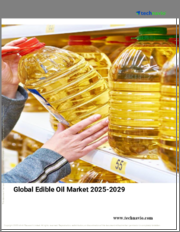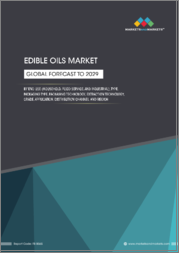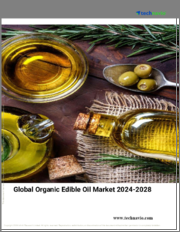
|
시장보고서
상품코드
1592803
인도의 식용유 시장 평가 : 특성별, 제품 유형별, 포장 유형별, 용도별, 지역별, 기회 및 예측(2018년-2032년)India Edible Oils Market Assessment, By Nature, By Product Type, By Packaging Type, By Application, By Region, Opportunities and Forecast, FY2018-FY2032F |
||||||
인도의 식용유 시장 규모는 2024년 198억 6,000만 달러에서 2032년 261억 9,000만 달러에 달할 것으로 예상되며, 2025-2032년의 예측 기간 동안 연평균 3.52%의 성장률을 보일 것으로 예상됩니다.
시장은 요리에의 활용 증가로 최근 큰 폭의 성장세를 보이고 있으며, 인도 요리에 없어서는 안 될 식재료라는 점에서 앞으로도 견조한 성장세를 유지할 것으로 전망됩니다.
인도의 풍부한 요리의 다양성과 가정 요리의 우수성은 인도의 식용유 시장의 성장을 지속적으로 촉진하고 있습니다. 또한, 인도 북부에서 주로 소비되는 겨자 오일, 남부에서 주로 소비되는 코코넛 오일 등 다양한 오일을 선택할 수 있는 지역적 다양성과 다양한 농작물이 시장 성장을 크게 촉진하고 있습니다. 인도 상공부의 추정에 따르면, 2021-2022년 인도는 세계 최대 코코넛 생산국으로 세계 총 생산량의 약 31.45%를 차지할 것으로 예상하고 있습니다. 또한, 이 작물은 인도의 GDP에 38억 8,000만 달러의 기여를 하고 있습니다. 이처럼 인도 남부의 코코넛 작물의 우수성은 순도, 가격, 접근성, 그리고 다른 오일보다 코코넛 오일의 순도, 가격, 접근성 등의 장점으로 인해 소비자들이 코코넛 오일을 선호하고 있습니다.
소비자 인식 증가와 정부 주도의 캠페인이 강화된 식용유 사용을 촉진하고 있습니다. 비타민 A와 비타민 D와 같은 비타민이 강화된 식용유는 영양 결핍을 해소하는 건강상의 이점으로 인해 소비자들 사이에서 인기를 끌고 있으며, 이러한 식용유에 대한 시장 수요를 촉진하고 있습니다. 예를 들어, 2024년 7월 Louis Dreyfus Company는 인도에서 Vibhor 식용유 브랜드를 리뉴얼하여 Vibhor Soyabean Oil, Mustard Oil, Pam olein Oil, Premium Vanaspati, Cottonseed Oil을 출시하였습니다. 출시하였습니다. 완전히 새로워진 이 제품 라인은 비타민 A와 비타민 D와 같은 필수 비타민을 풍부하게 함유하고 있어 건강하고 영양가 높은 식용유에 대한 현재 소비자들 수요를 충족시킵니다.
이 보고서는 인도의 식용유 시장을 조사 분석하여 시장 규모와 예측, 시장 역학, 주요 기업 현황 등을 제공합니다.
목차
제1장 프로젝트의 범위와 정의
제2장 조사 방법
제3장 주요 요약
제4장 고객의 소리
- 인구통계(연령/코호트 분석 - 베이비붐 세대, X세대, 밀레니얼 세대, Z세대, 성별, 소득 - 저소득, 중소득, 고소득, 지역, 국적 등)
- 시장 인지도와 제품 정보
- 브랜드 인지도와 로열티
- 구입 결정에서 고려되는 요소
- 순도와 품질
- 용이한 입수
- 건강상 이점
- 풍미
- 용도의 다양성
- 동료의 영향
- 구입 빈도
- 구입 매체
- 브랜드 앰베서더나 기업 마케팅이 제품/브랜드 침투에서 완수하는 역할
제5장 인도의 식용유 시장 전망(2018년-2032년)
- 시장 규모 분석과 예측
- 금액
- 수량
- 시장 점유율 분석과 예측
- 성질별
- 제품 유형별
- 포장 유형별
- 용도별
- 지역별
- 시장 점유율 분석 : 기업별(금액)(주요 5개사와 기타 - 2024년도)
- 시장 맵 분석(2024년도)
- 성질별
- 제품 유형별
- 포장 유형별
- 용도별
- 지역별
제6장 수급 분석
제7장 수출입 분석
제8장 밸류체인 분석
제9장 Porter의 Five Forces 분석
제10장 PESTLE 분석
제11장 거시경제 지표
제12장 가격 분석
제13장 이익률 분석
제14장 소비자 구매 행동 분석
제15장 시장 역학
- 시장 성장 촉진요인
- 시장이 해결해야 할 과제
제16장 시장 동향과 발전
제17장 사례 연구
제18장 경쟁 구도
- 시장 리더 주요 5개사의 경쟁 매트릭스
- 기업 생태계 분석(스타트업 vs. 중소기업 vs. 대기업)
- 주요 5개사의 SWOT 분석
- 주요 기업 주요 10개사 상황
- Dabur India Ltd.
- Adani Wilmar Limited
- Patanjali Ayurved Limited
- Cargill, Incorporated
- Louis Dreyfus Company B.V.
- BN Group(Nutrica)
- Organic India Pvt. Ltd.
- Marico Limited
- Emami Agrotech Ltd.
- BCL Industries Limited
제19장 전략적 추천
제20장 당사에 대해/면책사항
LSH 24.11.26India edible oils market is projected to witness a CAGR of 3.52% during the forecast period FY2025-FY2032, growing from USD 19.86 billion in FY2024 to USD 26.19 billion in FY2032.
The market has experienced significant growth in recent years due to a rise in culinary applications and is expected to maintain a strong pace of expansion in the coming years as it is a necessary ingredient in Indian cooking.
The rich culinary diversity of India and the dominance of home-cooked meals is continuously driving the growth for edible oils in India. Moreover, the regional diversity and varied agricultural crops have driven the market growth exponentially as the consumers have a wide variety of oils to choose from, such as mustard oil, which is majorly consumed in Northern India, and coconut oil, is largely consumed in Southern India. As per the estimates provided by the Department of Commerce, Ministry of Commerce and India, the Government of India, in FY2021-2022, India was the largest coconut-producing country worldwide, accounting for approximately 31.45% of the total global production. Moreover, the crop contributes USD 3.88 billion to the national GDP. Thus, the dominance of the coconut crop in South India is inducing consumers toward coconut oil more than other oils due to purity, affordability, and ease of availability.
The increasing awareness of consumers and government-led campaigns has driven the usage of fortified edible oils. Edible oils enriched with vitamins, such as vitamins A and D, are gaining popularity among consumers due to health benefits as they address nutritional deficiencies, driving the market demand for such oils. For instance, in July 2024, Louis Dreyfus Company relaunched Vibhor Edible Oil Brand in India, which includes Vibhor Soyabean Oil, Mustard Oil, Pam olein Oil, Premium Vanaspati, and Cottonseed Oil. This completely refreshed product line is enriched with essential vitamins such as vitamins A and D, which respond to the current consumer demand for healthy and nutritious edible oils.
Higher Production of Coconut Oil in Southern India to Drive the Market Growth
The large-scale production of coconut oil in South India is driving the edible oil market exponentially. The regional abundance and high-yield coconut cultivation are driving market growth as consumers increasingly prefer coconut oil in the region due to its easy availability and affordability. According to a study by the Ministry of Commerce and Industry, Government of India, in FY2021-FY2022, India's coconut production majorly comes from the Southern states, namely, Kerala, Karnataka, Tamil Nadu, and Andra Pradesh. The region accounts for 89.1% of the coconut area and leads to 90.04% of the coconut production in the country. Moreover, due to the higher production of coconut in the region, coconut oil has become a staple for ages and is traditionally used by consumers in everyday cooking and incorporation in traditional dishes, owing to its cultural significance.
Furthermore, the innovations by the key players in edible coconut oil, such as cold-pressed oil, virgin coconut oil, and organic coconut oil, have further driven the market growth as wider product variety and availability of healthier options attract different segments of consumers. In February 2022, Dabur India Ltd. announced the launch of Virgin Coconut Oil, which is 100% natural. It is an edible oil that can be used both for cooking and massaging, promoting skin and hair health.
PET Packaging Fostering the Growth
PET packaging of edible oil is preferred by consumers due to various significant reasons. The volume of a PET bottle is light, making them easy to handle and carry, offering convenience to the consumers. Also, PET packaging is resistant to breakage and is durable, thus eliminating possibilities of spillage and loss of the product, reducing wastage, and enhancing the consumers' experience by avoiding leakage of oil.
This quality PET packaging offers excellent barrier protection against air, moisture, and contaminant exposure to the oil, thereby protecting its freshness and extending its shelf life. Thus, ensuring quality to consumers who intend to preserve the nutritional value and flavor of their edible oils. Additionally, the recyclability of PET packaging appeals to environmentally conscious consumers interested in sustainable packaging.
In May 2024, Adani Wilmar Limited launched Fortune Pehli Dhaar pressed mustard in convenient 1-liter PET bottles and pouches in different states of India. The launch was made to elevate the mustard oil category and offer a premium product that caters to audiences preferring purity, taste, and tradition.
Government Initiatives to Supplement the Market Expansion
The government initiatives and its various subsidies and programs are driving the growth of edible oil market in India. This is because government schemes are formulated to increase the consumption of Indian-produced edible oil and increase the exports of oilseeds at the same time, reducing the potential imports of edible oils from foreign countries. For instance, in March 2024, the Government of India launched initiatives to promote oilseed production and reduce the imports of cooking oils. The government allocated a total amount of USD 1.32 million to reduce the edible oils import and help the country in becoming self-reliant in the oilseeds.
The increase in spending on research and development to improve edible oil farming techniques and oil extraction processes has further helped to enhance the production quality and efficiency of edible oils. The government launches various schemes for farmers and processors for encouraging higher production and efficient supply chain in the India edible oil market.
Future Market Scenario (FY2024 - FY2032F)
India edible oil has been witnessing rapid growth in the historical period and is expected to follow a similar growth trajectory in the forecast period as well. Consumers are increasingly switching to healthier oil and demanding pure and virgin oils that have been extracted and processed ethically.
Moreover, consumers prefer multi-purpose oils that are odorless and can be used in cooking and baking, expanding the utility of such edible oils. For instance, sunflower oil is less pungent and can be used in both baking and cooking different culinary dishes.
Key Players Landscape and Outlook
Key players in the market are helping the growth by focusing on continuous product innovation, retail expansions, and strategic marketing. The manufacturers are actively expanding their product portfolio, increasing their customer base, and catering to their evolving needs.
The key players are expanding their operations in niche markets where consumers do not commonly use edible oils. For instance, in February 2023, Cargill, Incorporated launched Gemini Pureit in Karnataka, Telangana, Andra Pradesh, and Tamil Nadu. The expansion of the brand in South India was supported by its acquisition of a facility in Nellore, Andra Pradesh, which initiated its operations in December 2022. The USD 35 million investment to acquire and upgrade the Nellore facility has significantly expanded its operations in South India.
Table of Contents
1. Project Scope and Definitions
2. Research Methodology
3. Executive Summary
4. Voice of Customer
- 4.1. Demographics (Age/Cohort Analysis - Baby Boomers and Gen X, Millennials, Gen Z; Gender; Income - Low, Mid and High; Geography; Nationality; etc.)
- 4.2. Market Awareness and Product Information
- 4.3. Brand Awareness and Loyalty
- 4.4. Factors Considered in Purchase Decisions
- 4.4.1. Purity and Quality
- 4.4.2. Ease in Availability
- 4.4.3. Health Benefits
- 4.4.4. Taste
- 4.4.5. Versatility in Application
- 4.4.6. Peer Group Influence
- 4.5. Frequency of Purchase
- 4.6. Medium of Purchase
- 4.7. Role of Brand Ambassador or Influencer Marketing on Product/Brand Absorption
5. India Edible Oils Market Outlook, FY2018-FY2032F
- 5.1. Market Size Analysis & Forecast
- 5.1.1. By Value
- 5.1.2. By Volume
- 5.2. Market Share Analysis & Forecast
- 5.2.1. By Nature
- 5.2.1.1. Organic
- 5.2.1.2. Conventional
- 5.2.2. By Product Type
- 5.2.2.1. Mustard Oil
- 5.2.2.2. Palm Oil
- 5.2.2.3. Groundnut Oil
- 5.2.2.4. Coconut Oil
- 5.2.2.5. Sunflower Oil
- 5.2.2.6. Others
- 5.2.3. By Packaging Type
- 5.2.3.1. Cans
- 5.2.3.2. Bottles
- 5.2.3.3. Pouches
- 5.2.3.4. Jars
- 5.2.3.5. Others
- 5.2.4. By Application
- 5.2.4.1. Seasoning
- 5.2.4.2. Frying
- 5.2.4.3. Baking
- 5.2.4.4. Food Processing
- 5.2.4.5. Others
- 5.2.5. By Region
- 5.2.5.1. East
- 5.2.5.2. West and Central
- 5.2.5.3. North
- 5.2.5.4. South
- 5.2.6. By Company Market Share Analysis (Top 5 Companies and Others - By Value, FY2024)
- 5.2.1. By Nature
- 5.3. Market Map Analysis, FY2024
- 5.3.1. By Nature
- 5.3.2. By Product Type
- 5.3.3. By Packaging Type
- 5.3.4. By Application
- 5.3.5. By Region
All segments will be provided for all regions covered
6. Demand Supply Analysis
7. Import and Export Analysis
8. Value Chain Analysis
9. Porter's Five Forces Analysis
10. PESTLE Analysis
11. Macro-economic Indicators
12. Pricing Analysis
13. Profit Margin Analysis
14. Consumer Buying Behavior Analysis
15. Market Dynamics
- 15.1. Market Drivers
- 15.2. Market Challenges
16. Market Trends and Developments
17. Case Studies
18. Competitive Landscape
- 18.1. Competition Matrix of Top 5 Market Leaders
- 18.2. Company Ecosystem Analysis (Startup v/s SME v/s Large-scale)
- 18.3. SWOT Analysis for Top 5 Players
- 18.4. Key Players Landscape for Top 10 Market Players
- 18.4.1. Dabur India Ltd.
- 18.4.1.1. Company Details
- 18.4.1.2. Key Management Personnel
- 18.4.1.3. Products and Services
- 18.4.1.4. Financials (As Reported)
- 18.4.1.5. Key Market Focus and Geographical Presence
- 18.4.1.6. Recent Developments/Collaborations/Partnerships/Mergers and Acquisition
- 18.4.2. Adani Wilmar Limited
- 18.4.3. Patanjali Ayurved Limited
- 18.4.4. Cargill, Incorporated
- 18.4.5. Louis Dreyfus Company B.V.
- 18.4.6. BN Group (Nutrica)
- 18.4.7. Organic India Pvt. Ltd.
- 18.4.8. Marico Limited
- 18.4.9. Emami Agrotech Ltd.
- 18.4.10. BCL Industries Limited
- 18.4.1. Dabur India Ltd.
Companies mentioned above DO NOT hold any order as per market share and can be changed as per information available during research work.



















